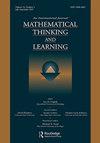Examining the effects of an intervention on mathematical modeling in problem solving at upper elementary grades: a cluster randomized trial study
IF 1.5
4区 教育学
Q2 EDUCATION & EDUCATIONAL RESEARCH
引用次数: 0
Abstract
ABSTRACTAlthough mathematical modeling during problem solving has attracted increased scholarly interest, existing quantitative work in this field has largely concentrated on secondary and tertiary education. Using a cluster-randomized-trial design, this study explored the contribution of an intervention aiming to support upper elementary students’ problem-solving modeling performance. The analytic sample of the study consisted of 50 Grade 5 and 6 classes (815 students) whose teachers volunteered to participate in the study; the classes were assigned to either an experimental (25 classes) or a control condition (25 classes), each receiving five 80-minute lessons on either modeling activities or solving routine and process problems, respectively. Student problem-solving modeling performance was measured before, right after, and two months after the culmination of the intervention. The person estimates emerging from a Rasch analysis of these data were analyzed using inferential statistics and a multi-level piecewise linear growth model. The analyses showed that students in the experimental group outperformed their counterparts in the control group both at the immediate and late test administration. Additionally, fifth graders in the experimental group outperformed sixth graders in the control group. We discuss the implications of these findings for teaching modeling during problem solving in elementary grades.KEYWORDS: Cluster randomized trial studyelementary gradesinterventionmodelingproblem solving AcknowledgmentsWe would like to thank the teachers and the students participating in this study. Without their contribution, this study would not have been possible.Disclosure statementNo potential conflict of interest was reported by the author(s).Supplementary materialSupplemental data for this article can be accessed online at https://doi.org/10.1080/10986065.2023.2270088.Notes1. This limited number of experimental studies in elementary grades should not imply a scarcity of studies on mathematical modeling in these grades. In fact, there is a rich corpus of non-experimental, qualitative studies that have explored how teaching can support elementary school students in improving their mathematical modeling competence. By adopting a longitudinal design, some of these studies have shown how mathematical modeling activities spread over several years can support the modeling competence of elementary school students in lower (e.g., English, Citation2012; English, L. D, Citation2011) or upper grades (e.g., English, Citation2022, Citation2023; English & Watson, Citation2018). Qualitative studies have also shown the potential of mathematical modeling interventions occurring within a single year to improve the mathematical modeling performance of even Gr.1 (Keisar & Peled, Citation2018) or Gr.2 (Albarracin, Citation2021) students.2. Although 998 students were invited to participate in the study (which was approved by the National Center for Educational Research and Evaluation), the analytic sample included 815 students because the parents of 90 students did not give consent to their children’s participation. Also, no complete datasets were available for 93 students because of absences during the test administrations or transfers to other schools/immigration halfway through the conduct of the study.3. Based on information obtained from the school principals, 10 classes were of low SES (5 experimental and 5 control), 29 were of medium SES (15 experimental and 14 control), and 11 were of high SES (5 experimental and 6 control).4. As O’Connor and Joffe (Citation2020) note, although there is little consensus regarding the proportion of the data set that facilitates a trustworthy estimate for inter-rater reliability purposes, double-coding 10%-25% of data units is typical. Although using a higher percentage of tests for checking for inter-rater reliability would have been optimal, due to financial constraints we opted for the lower bound of this interval.Additional informationNotes on contributorsYiannis CharalambousYiannis Charalambous is an elementary school principal. He holds a Ph.D. in Mathematics Education and a Master’s degree in Mathematics and Science Education. He has special interest in problem solving and in particular in mathematical modeling during the problem-solving process.Charalambos Y. CharalambousCharalambos Y. Charalambous is an Associate Professor in the Department of Education at the University of Cyprus, specializing in Educational Research and Evaluation. His research interests include teaching effectiveness with a particular focus on understanding and measuring the work of teaching and its effects on student learning. He is also interested in teacher initial training and teacher professional development through guided reflection on practice.检验干预对小学高年级数学模型解决问题的影响:一项聚类随机试验研究
虽然数学建模在问题解决过程中引起了越来越多的学术兴趣,但现有的定量工作主要集中在中等和高等教育领域。本研究采用聚类随机试验设计,探讨一项干预措施对小学高年级学生解决问题的建模能力的影响。本研究的分析样本包括50个五年级和六年级的班级(815名学生),他们的教师自愿参与研究;这些班级被分配到实验(25个班级)或控制条件(25个班级),每个班级分别接受5次80分钟的课程,分别是建模活动或解决常规和流程问题。在干预结束前、之后和两个月后分别测量了学生解决问题的模型表现。从这些数据的Rasch分析中得出的人员估计使用推理统计和多层次分段线性增长模型进行分析。分析表明,实验组的学生在考试前和考试后的表现都优于对照组的学生。此外,实验组的五年级学生比对照组的六年级学生表现得更好。本研究将讨论这些研究结果对小学问题解决过程中建模教学的启示。关键词:聚类随机试验研究,干预,建模,解决问题感谢参与本研究的老师和学生。没有他们的贡献,这项研究是不可能的。披露声明作者未报告潜在的利益冲突。补充材料本文的补充数据可在https://doi.org/10.1080/10986065.2023.2270088.Notes1上在线获取。这有限的实验研究在小学年级不应该意味着缺乏研究的数学建模在这些年级。事实上,有大量的非实验定性研究探讨了教学如何支持小学生提高数学建模能力。通过采用纵向设计,其中一些研究表明,数学建模活动在几年的时间内如何支持小学生的建模能力(例如,英语,Citation2012;英语,L. D, Citation2011)或更高等级(例如,英语,Citation2022, Citation2023;English & Watson, Citation2018)。定性研究还表明,在一年内发生的数学建模干预有可能提高1级(Keisar & Peled, Citation2018)或2级(Albarracin, Citation2021)学生的数学建模性能。虽然998名学生被邀请参加这项研究(这是由国家教育研究和评估中心批准的),但分析样本包括815名学生,因为90名学生的父母不同意他们的孩子参与。此外,由于在考试管理期间缺席或转学或中途移民,93名学生没有完整的数据集。3 .根据学校校长提供的信息,低经济地位班10个(实验5个,对照组5个),中等经济地位班29个(实验15个,对照组14个),高经济地位班11个(实验5个,对照组6个)。正如O 'Connor和Joffe (Citation2020)所指出的那样,尽管对数据集的比例没有达成共识,但对于评分者之间可靠性的可靠估计,10%-25%的数据单元进行双重编码是典型的。虽然使用更高百分比的测试来检查评级者之间的可靠性是最佳的,但由于财务限制,我们选择了这个区间的下限。作者简介:syiannis Charalambous syiannis Charalambous是小学校长。他拥有数学教育博士学位和数学与科学教育硕士学位。他对解决问题特别感兴趣,特别是在解决问题的过程中建立数学模型。Charalambos Y. Charalambous是塞浦路斯大学教育系的副教授,专门从事教育研究和评估。他的研究兴趣包括教学有效性,特别侧重于理解和衡量教学工作及其对学生学习的影响。他还对教师的初始培训和教师专业发展通过指导反思实践感兴趣。
本文章由计算机程序翻译,如有差异,请以英文原文为准。
求助全文
约1分钟内获得全文
求助全文
来源期刊

Mathematical Thinking and Learning
EDUCATION & EDUCATIONAL RESEARCH-
CiteScore
4.40
自引率
6.20%
发文量
18
 求助内容:
求助内容: 应助结果提醒方式:
应助结果提醒方式:


